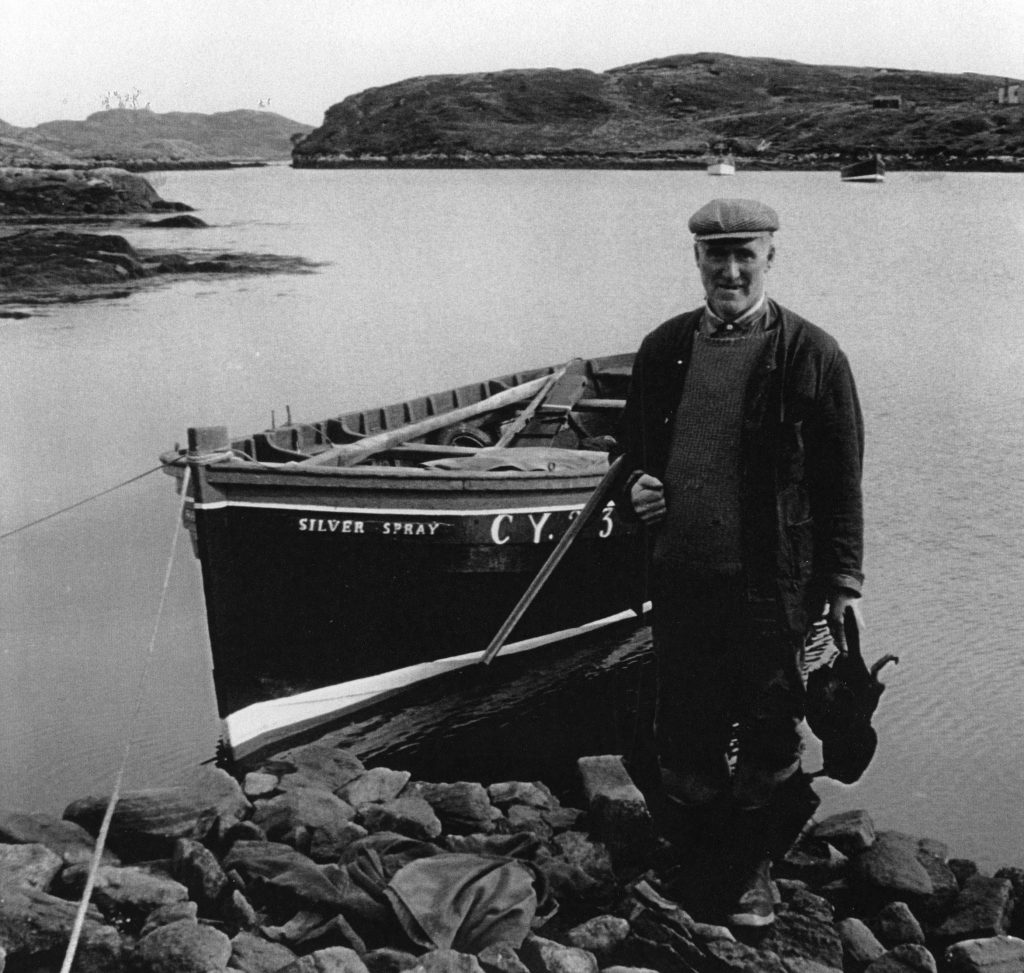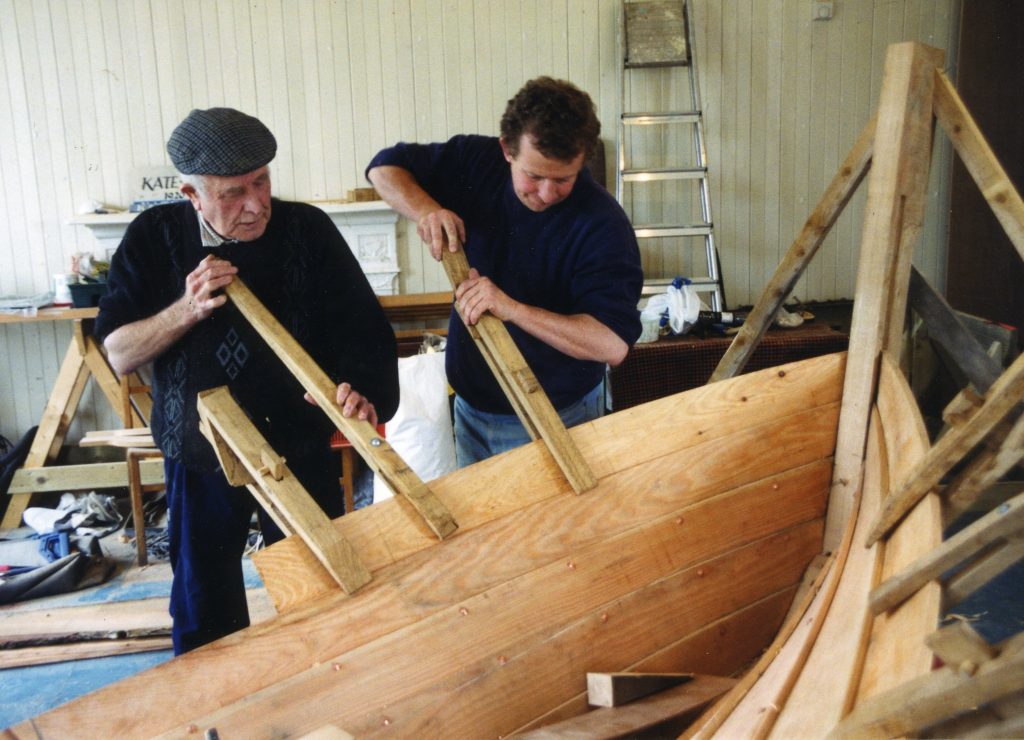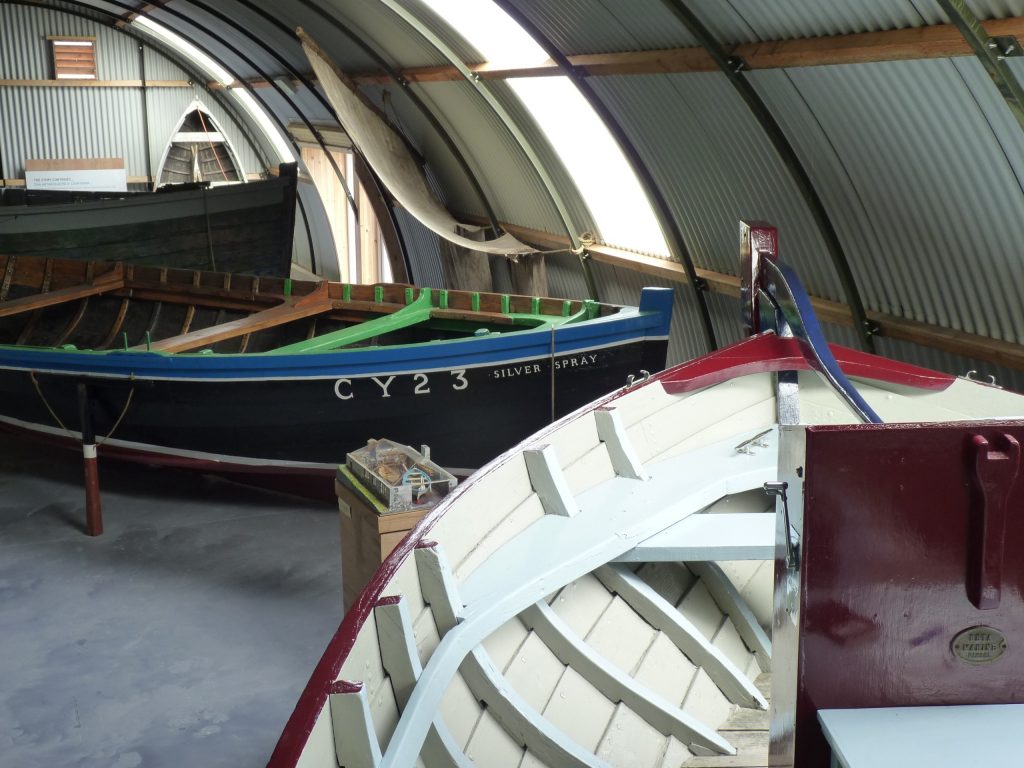Episode Three
by Helen Voce
In April 2020, as lockdown established its hold, Grimsay Boat Haven marked its 20 year community-based research journey with a virtual launch. The only maritime heritage centre in the Western Isles of Scotland, Grimsay Boat Haven preserves and interprets the finest remaining examples of the Grimsay Boat – a workboat built since the 1840s by four generations of the Stewart family, from the island of Grimsay off North Uist.

“The Grimsay Boat Haven records the unbroken line in this island fishing and crofting community for 150 years.“
Mary Norton, Boat Haven curator and editor of Never Broken at Sea: The Hebridean Workboats of Grimsay
Grimsay (Griomsaigh) is a tidal island, four miles long by two wide, located between, and since 1960 connected to Benbecula and North Uist by the North Ford Causeway. In response fishing and crofting lives of those living across Uist on Atlantic waters, the Stewart family developed a sophisticated and distinctive boat design:
“…small enough to be kept safely in rocky inlets off the Minch, but fast, strong and stable for the lobster fishing in the Atlantic and maneouvrable in sandy shallows. The Stewarts were creative in their approach: their designs survived the transition from sail to power through flexibility and adaptation.”
The Grimsay Boat Story text by Mary Norton
“The secret of the Stewart boats is in their hull form, especially the uisge, or part under the water: it is fine in forefoot to slip easily through the sea, deep in the keel for stability and ‘a good grip on the water’, then flares to a broad working platform. To achieve these goals, the uisge must be carefully shaped.
The Stewart method of building made such shaping possible. Most strakes (planks) were made in 3 pieces. This not only saved timber but meant that each section could be shaped individually, giving more refined curves than could be cut from a single plank.
Another Stewart secret was their skill at ‘eye-building’. This meant that boats were made individually without any forms or moulds. The builder had to see the finished hull in his mind and make tiny adjustments to each bit of planking to achieve it. The skill of ‘eye-building’ is very rare, and explains the Stewart flexibility in design, responding to the needs of each fisherman or crofter.”
The Grimsay Boat Story text by Mary Norton
Timber usually came by puffer from Glasgow as ‘boatskin’, with boat builders preferring larch due to its high resin content for the lapped strakes of the clinker-built boat attached to an oak backbone. At one time, there were three boat builders from the Stewart family on Grimsay – the family are reputed to have built as many as 1,000 boats for local lobster fisherman and crofters since the 1840s. With the advent of improved engines and better transport to the mainland, commercial lobster fishing became viable and the small sail and oar powered family boats became larger as fishing boomed after the Second World War.

Photograph Mary Norton
Constructed in 1928, the Morning Star was the first boat built by the Stewart family to be powered by engine alone. One of five of the best remaining examples of Stewart built boats on display at Grimsay Boat Haven, Morning Star’s history highlights the importance of the Grimsay Boat to island communities. The boat’s near-100 year history as a postal service to the Monach Isles (Heisgeir) Lighthouse, transporter of cattle, coal and tourists, and registered fishing boat was charted during its restoration in the early 2000s in Turning the Tide, a heritage, craft and community project run by the Boatshed at Taigh Chearsabhagh Museum and Arts Centre in Lochmaddy, North Uist and the Grimsay Boatshed in Kallin on Grimsay. Also on show is Silver Spray, built in 1949 for a Grimsay fishing family, she is a classic example of the commercially-successful mid-century ‘ring-frame’ lobster boats. Repaired with the assistance of apprentices at Grimsay Boatshed, Silver Spray was donated to the Scottish Fisheries Museum’s, and is now on loan to the Boat Haven.

Photograph Mary Norton
As part of the Grimsay Community Association (GCA), Grimsay Boat Haven is a new development at the Community Centre at Ceann na h-Àirigh in Scotvein, Grimsay. The Centre converted the former Free Church and manse into a community hub with a Post Office, café and Gathering Space for events. Established in 1999, GCA addresses aspects of island life from the boats to the Gaelic language and tradition as well as daily concerns such as water quality, connectivity and development, and is a means to link with other Hebridean island communities and the Grimsay diaspora. The Grimsay Boat Haven is complemented by the local history archive in the Centre which documents and preserves the history of the boats.
Shellfish has long been Grimsay’s main industry, with a base at Kallin Harbour. The daily haul is mostly lobster, prawns and scallops caught in the local waters from the Minch to the Monach Isles (Heisgeir) seven miles to the west in the Atlantic. As traditional fishing grounds of the Grimsay fishermen and a formerly inhabited island cluster, the Grimsay community has a strong historical connection with Heisgeir and have restored the Schoolhouse on Ceann Ear. In 2003 the Grimsay Boatshed was founded by fisherman and the Grimsay Boat Project near Kallin Harbour to preserve the vernacular Grimsay Boat building tradition and maintain the local fishing fleet. The Grimsay Boatshed Trust, employs aBoatbuilder / Craftsman Manager Ronald John MacLean who learnt his boatbuilding skills from Uilleam Theàrlaich, or Willie, the last boat builder in the Stewart family. In turn Ronald John passes on his traditional boat building skills to young people through education projects, apprenticeships and traineeships.
The actual opening of Grimsay Boat Haven will take place as soon as is safely possible. Until then, you can take a virtual tour and hear from North Uist born model maker the Rev Donald MacQuarrie, who states, ‘Often I would think to myself am I the only one that looks at the boats sitting in a calm water or cutting through a wave and think what a beautiful object to complement the world of nature.’
There is more on Grimsay’s Heritage, including the Stewart family and the boats they built and the unique Creek Books, is a register of the mid-20th century fishing boats. Or order a copy of Never Broken at Sea: The Hebridean Workboats of Grimsay or the DVD about Heisgeir Through the Ford from GCA Shop. GCA would welcome those who have any images of Grimsay boats to get in touch.
Thank you to Mary Norton of Grimsay Community Association for her assistance with this article.
Grimsay Boat Haven and the virtual launch
Heisgeir, the restoration of the Schoolhouse and the Fair Island Exhibition
Taigh Chearsabhagh Museum and Arts Centre and the Turning the Tide project
Helen Voce is an independent producer working locally, nationally, internationally and voluntarily in the creative industries. Her professional specialism and personal interest is in contemporary craft and design in Scotland, the UK and beyond. Current projects include the MAKE Manifesto, Make Works Scotland, mentoring for Vanilla Ink and Craft Scotland, the Tanween Development Programme at Tashkeel in the UAE, plus professional development projects for Applied Arts Scotland. Former clients include Cove Park, Crafts Council and Firstport.
